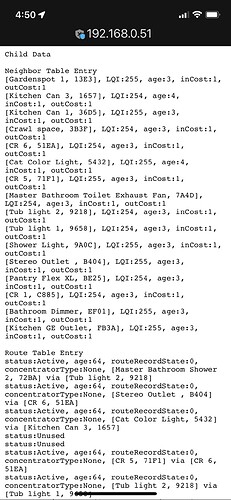Apologies in advance for so many posts from me about this app, but I’m at my wits end, and I could use some advice. I can’t get the app to work reliably. Some specific issues I have are:
Grouped bulbs, where the group is set to use zigbee group messaging, don’t appear to do so when controlled by a scene. I have a ceiling fan fixture that has a pair of bulbs in it, which I’ve grouped. Commands to the group usually produce the desired result, if the command is sent from the Hubitat interface. Commands to the group coming from Alexa can be a bit hit and miss, because it seems that the Alexa app won’t send them if it thinks they aren’t necessary. Commands to the group from a Scene appear to iterate through the devices in the group, rather than using the group messaging.
The result is that my ceiling fan lights are never in a consistent state. I have multiple scenes (morning, daytime, relaxing, evening) that change their color temperature, or RGB throughout the day. Invariably, the bulbs will have one in the correct state, and the other in the previous state. They’re Sylvania LEDvance bulbs using the Generic RGBW driver, because the Advanced driver has another host of issues, which I’ll get into later. I have to ask Alexa to turn the scene on 2 or 3 times before everything gets in the right state.
This doesn’t apply to just those bulbs. I’ve also got Sylvania light strips (same driver) that, for other scenes (TV, cooking, gaming, movie) will change color, color temperature, and level. More often than not, I’ll get two of the three (usually on/off state and level, but not color) when the scene is activated, but not all three. Sometimes it’ll get the on/off state and color, but not the level.
This also happens to GE-branded Jasco dimmer switches. The scene will have it captured as on, 40%. The scene will turn it on, but not assign the level. Or it’ll pre-stage the level, but not turn it on. I have to run the scene activation multiple times to get the LED strips and dimmer switches to the desired scene state.
I have turned on metering for these scenes (it appears to help, but only marginally). The groups have zigbee group messaging turned on. (I’ve also tried turning it off.) The groups are configured to report the on state of any bulb as the state for the group, as I’ve previously had issues with the groups not turning off completely. I have discrete on for activation turned on for the scenes (tried it off too) and level/color pre-staging enabled where I can (and tried it with it off too). All the devices shown in the route table look healthy, with strong signal. I have activation optimization turned off for the scenes, because that just makes the unreliable results even more unreliable.
The result of all this is that I have to do things like say “Alexa, turn on relaxing illumination,” then wait for the scene to run through its metering for several seconds. Then I have to say it again, and wait again. Then I have to say it a third time. Usually that will get everything where it’s supposed to be.
I don’t have these issues controlling devices individually, but then, I’m not changing multiple state properties by voice when I do that.
I’ve posted about some of this before and some folks suggested my bulbs are killing the mesh, or I should put them on a Hue bridge. I don’t think they are, and I don’t think I will, because this entire setup used to work flawlessly on my Lightify hub. That thing seemed to use group messaging to activate scenes, because there was no popcorn effect at all, and everything immediately went to the desired state for level, power, and color.
I really, really want these scenes to work. I’ve invested a lot of time and effort in crafting them, and when they do work, it’s beautiful and exactly what I want. I don’t know if there’s something trying to economize zigbee traffic that is making my HE be stingy with commands, or something that makes grouped devices ignore the group messaging flag when run by a scene, or something that is making it impossible to do level, CT/color, and power state all at once, or some combination of all or none of the above, but the result is my scenes are broken and have to be triply run in order to get everything where it needs to be.
I’m in a 780sq. ft. apartment, and I’ve moved the zigbee channel as far away from my 2.4ghz wifi as I can. The route table shows what appears to be a healthy mesh. The scene commands just aren’t getting to the devices in a way that makes the devices behave the way I want for the scenes. The number of devices in play and the different configuration options I can set at the device, group, and scene level has made my efforts at logging and debugging fruitless. There’s just too much information, and the results are too inconsistent to be meaningful to me.
I could really use help with this. 



